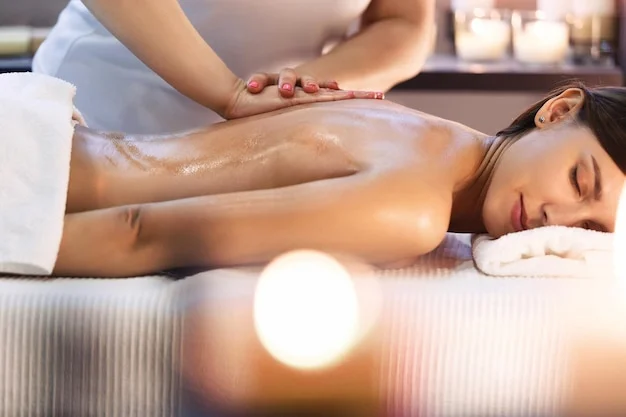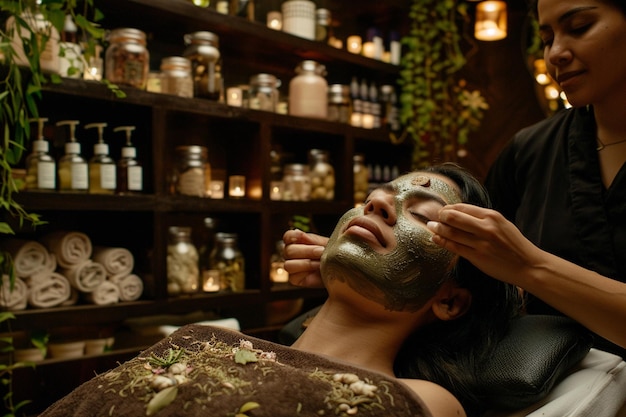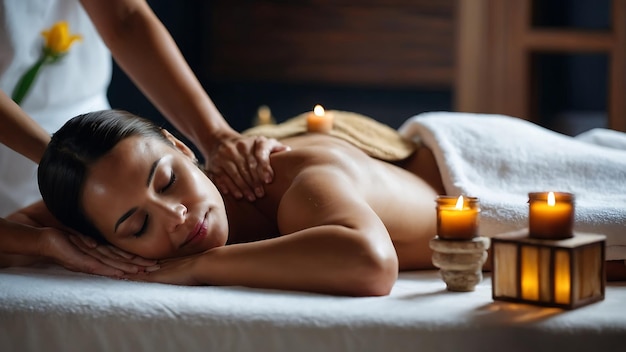Ask Ayurvedic doctor a question and get a consultation online on the problem of your concern in a free or paid mode. More than 2,000 experienced doctors work and wait for your questions on our site and help users to solve their health problems every day.
Shop Now in Our Store
Utsadana – Ayurvedic Therapeutic Massage for Detoxification and Vitality

Introduction to Utsadana
Utsadana is a traditional Ayurvedic therapeutic massage that is primarily aimed at promoting detoxification, reducing stress, and rejuvenating the body. This form of massage involves the application of herbal pastes or oils to the body, which are massaged into the skin using specific techniques to release toxins, improve circulation, and stimulate the lymphatic system. Utsadana is known for its ability to provide deep nourishment, enhance vitality, and restore balance to the body's doshas. It is a powerful treatment often used in Ayurvedic detoxification programs, such as Panchakarma, and can be a key component of a holistic approach to wellness.
Historical Roots & Ayurvedic Significance
Utsadana has been practiced for centuries as part of Ayurvedic healing traditions, where it is considered an essential therapy for improving overall health and vitality. The practice of using medicinal herbs in oil or paste form for massage has deep roots in Ayurvedic texts, where it is believed to balance the body's energies and promote health from the inside out. The process helps to clear Ama (toxins) from the tissues, regulate the flow of Prana (life force), and restore harmony between the body and mind.
The term "Utsadana" comes from the Sanskrit word "Utsada," meaning "to elevate" or "to uplift," reflecting the therapeutic benefits of the massage in boosting physical and mental well-being. This treatment is widely used for stress relief, improving skin texture, and promoting detoxification.
Key Components & Therapeutic Benefits
1. Herbal Pastes and Oils
The main components of Utsadana are herbal pastes and oils that are applied to the body during the massage. These pastes and oils are made from a variety of Ayurvedic herbs, each chosen for its specific therapeutic benefits. Some commonly used herbs include:
- Turmeric (Curcuma longa): Known for its anti-inflammatory and antioxidant properties, turmeric helps to detoxify the body, reduce pain, and improve skin health.
- Sandalwood (Santalum album): Sandalwood is soothing for the skin, helping to relieve inflammation, calm the mind, and improve circulation.
- Neem (Azadirachta indica): Known for its antibacterial, antifungal, and anti-inflammatory properties, neem helps to cleanse the skin and remove impurities.
- Ashwagandha (Withania somnifera): An adaptogenic herb that helps reduce stress, improve vitality, and balance the body’s energies.
- Sesame Oil: Often used as the base oil for Utsadana, sesame oil is deeply nourishing and penetrates the skin to deliver the medicinal properties of the herbs used.
2. Detoxification and Toxin Removal
One of the primary benefits of Utsadana is its ability to support the body’s natural detoxification process. The herbal oils and pastes used in Utsadana help to eliminate Ama (toxins) from the tissues, which can accumulate due to poor digestion, unhealthy lifestyle, or stress. Regular Utsadana massages stimulate the lymphatic system, aiding in the removal of waste products from the body and improving overall health.
3. Stress Relief and Relaxation
Utsadana is highly effective in reducing stress and promoting relaxation. The massage techniques used during Utsadana are designed to calm the nervous system, release tension in the muscles, and relax the mind. The soothing effects of the herbal oils also promote mental clarity, reduce anxiety, and enhance overall well-being. This makes Utsadana an excellent therapy for individuals dealing with stress, burnout, or mental fatigue.
4. Skin Rejuvenation
The herbal oils and pastes used in Utsadana are deeply nourishing for the skin. They improve skin texture, tone, and elasticity, and promote a youthful glow. Utsadana is particularly beneficial for improving circulation to the skin, which can help to address issues like dryness, acne, and dullness. The natural ingredients in the oils also help hydrate and soften the skin, making it look healthier and more radiant.
5. Improved Circulation and Mobility
The massage techniques used in Utsadana stimulate blood flow and improve circulation, which can help alleviate muscle stiffness, joint pain, and inflammation. By promoting better circulation, Utsadana helps nourish the tissues, improve flexibility, and enhance mobility. It is particularly beneficial for individuals suffering from conditions like arthritis, muscle tension, or poor circulation.
6. Balancing the Doshas
Utsadana helps balance the body's three doshas—Vata, Pitta, and Kapha—by addressing imbalances in the body’s energy systems. It is particularly effective in reducing Vata and Kapha dosha imbalances, which are often associated with conditions like dryness, fatigue, and congestion. The application of warm herbal oils and pastes can help bring harmony to the doshas, promoting overall health and balance.
How Utsadana Works: The Science Behind the Therapy
Utsadana works by applying herbal oils and pastes to the skin, where they are absorbed into the body. The oils and herbs penetrate the skin, delivering their medicinal properties directly to the tissues. The massage techniques used help stimulate the blood and lymphatic systems, promoting circulation and encouraging the removal of toxins. The application of warm herbal pastes also promotes Srotas (channels) in the body, improving the flow of energy, nutrients, and waste products.
The gentle but firm pressure used during the massage helps to relieve muscle tension, activate the Marma points (vital energy points), and balance the flow of Prana throughout the body. The use of natural oils enhances the healing process, supporting detoxification, rejuvenation, and overall wellness.
How to Perform Utsadana
Utsadana is typically performed by a trained Ayurvedic practitioner, but it can also be done at home with the right guidance. Here’s how it is generally done:
- Prepare the Herbal Paste/Oil: Choose a suitable Ayurvedic oil or paste based on your specific skin type and health condition. You can consult an Ayurvedic practitioner to determine which oils or herbs are best suited for your needs.
- Heat the Oil: Slightly warm the oil or paste to enhance its therapeutic effects. Make sure the oil is not too hot to avoid discomfort.
- Apply the Oil: Begin by applying the oil or paste to the body, starting from the feet and working your way upwards in circular motions. Focus on areas that are particularly tense or stiff, such as the shoulders, neck, and joints.
- Massage the Body: Use gentle to moderate pressure while massaging the oil into the skin. Perform the massage in a rhythmic manner to promote relaxation and stimulate blood flow.
- Leave the Oil on the Skin: After the massage, leave the oil on the skin for 15-30 minutes, allowing it to absorb and take effect.
- Rinse Off: After the oil has been absorbed, rinse the body with warm water or take a warm bath to remove any excess oil.
Potential Side Effects & Precautions
While Utsadana is generally safe for most individuals, there are a few precautions to keep in mind:
- Allergic Reactions: Perform a patch test before applying any herbal oils or pastes to large areas of the skin to check for allergic reactions.
- Sensitive Skin: Individuals with sensitive or allergic skin may experience irritation. If irritation occurs, discontinue use and consult a healthcare provider.
- Pregnancy: Pregnant women should consult an Ayurvedic practitioner before undergoing Utsadana to ensure the therapy is safe for both the mother and baby.
- Avoid Overuse: While Utsadana is beneficial, overuse of strong herbs or oils may lead to skin irritation or other side effects. Use the treatment as directed.
Frequently Asked Questions for Utsadana
What is Utsadana used for?
Utsadana is used for detoxification, stress relief, skin rejuvenation, and improving joint and muscle health. It helps balance the doshas, reduce inflammation, and promote overall vitality.
How does Utsadana help with detoxification?
The herbal oils and pastes used in Utsadana help cleanse the body by removing toxins (Ama) from the tissues, improving circulation, and stimulating the lymphatic system to flush out waste products.
Can Utsadana be used for stress relief?
Yes, Utsadana is highly effective for reducing stress and promoting relaxation. The massage techniques and soothing oils help calm the nervous system, reduce tension in the muscles, and improve mental clarity.
Is Utsadana good for skin health?
Utsadana is excellent for skin health. The herbs and oils used nourish the skin, improve blood circulation, reduce dryness, and promote a radiant complexion. It also helps detoxify the skin and alleviate conditions like acne and pigmentation.
How often should I perform Utsadana?
Utsadana can be performed once or twice a week, depending on your health needs. For general wellness, it can be done once a week, while for detoxification or skin issues, more frequent sessions may be recommended.
Can Utsadana be combined with other Ayurvedic therapies?
Yes, Utsadana can be combined with other Ayurvedic treatments like Abhyanga (oil massage) or Panchakarma for enhanced detoxification and overall health benefits.
Where can I find a qualified Utsadana practitioner?
Qualified practitioners can be found at Ayurvedic wellness centers or spas. It is important to choose a licensed Ayurvedic practitioner who specializes in traditional therapies like Utsadana.
Conclusion & Expert Insights
Utsadana is a powerful Ayurvedic therapeutic massage that promotes detoxification, reduces stress, improves skin health, and enhances overall vitality. By incorporating this holistic treatment into your wellness routine, you can experience a range of benefits, from improved circulation to enhanced skin radiance. As always, it’s important to consult with an Ayurvedic practitioner to ensure that Utsadana is tailored to your individual health needs.
References & Further Reading
- Lad, V. (2002). Ayurveda: The Science of Self-Healing.
- Sharma, P.V. (1995). Dravyaguna Vijnana: A Textbook of Ayurvedic Pharmacology.
- National Institute of Ayurveda:
- Journal of Ayurveda and Integrative Medicine for research articles on Ayurvedic therapies and detoxification.
This article is checked by the current qualified Dr Sujal Patil and can be considered a reliable source of information for users of the site.



